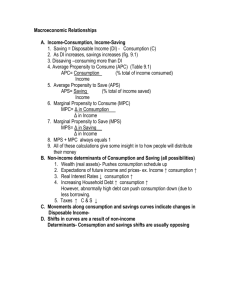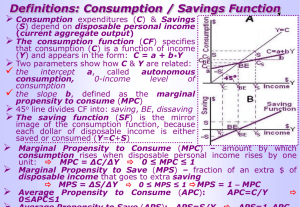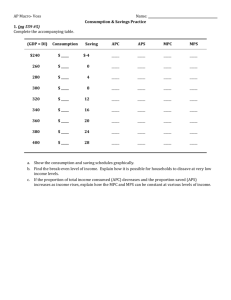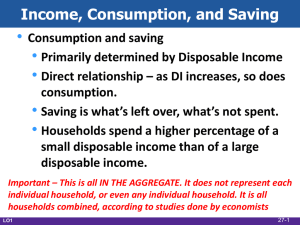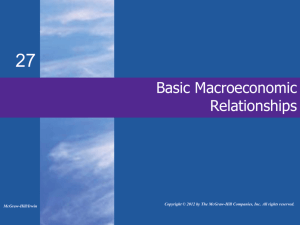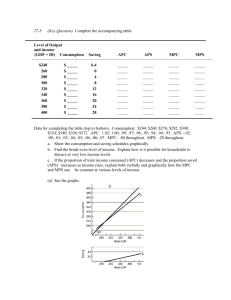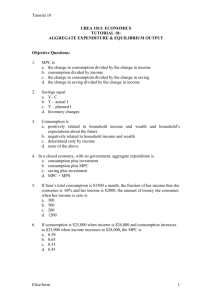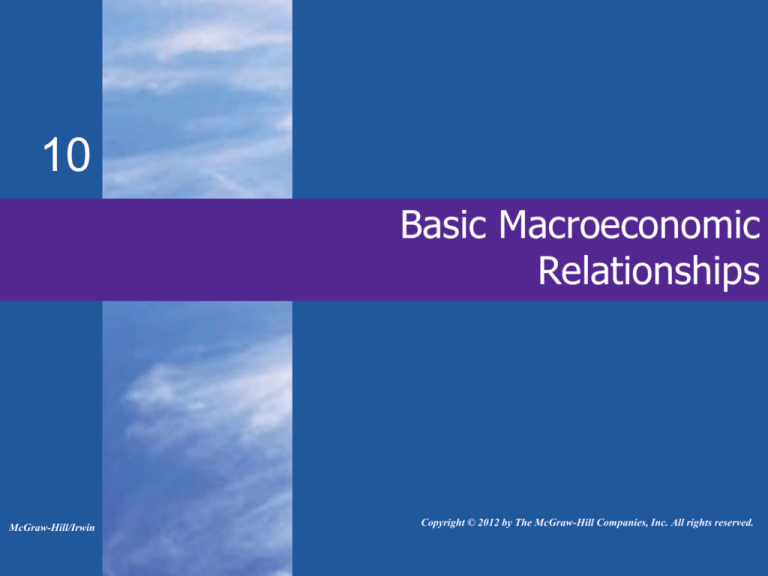
10
Basic Macroeconomic
Relationships
McGraw-Hill/Irwin
Copyright © 2012 by The McGraw-Hill Companies, Inc. All rights reserved.
Chapter Objectives
• Effect of changes in income on
consumption (and saving)
• Other factors that affect consumption
• Effect of changes in real interest rates
on investment
• Other factors that affect investment
• Changes in investment have a
multiplier effect on real GDP
27-2
Income Consumption and Saving
• Consumption and saving
• Primarily determined by DI
• Direct relationship
• Consumption schedule
• Planned household spending (in our
•
LO1
model)
Saving schedule
• DI minus C
• Dissaving can occur
10-3
Income, Consumption, and Saving
LO1
10-4
Average Propensities
• Average propensity to consume (APC)
• Fraction of total income consumed
• Average propensity to save (APS)
• Fraction of total income saved
consumption
APC =
income
APS =
saving
income
APC + APS = 1
LO1
10-5
Consumption (billions of dollars)
Consumption and Saving Schedules
500
C
475
450
425
Saving $5 billion
Consumption
schedule
400
375
Dissaving $5 billion
Saving
(billions of dollars)
45°
370 390 410 430 450 470 490 510 530 550
50
25
0
Dissaving Saving schedule
S
$5 billion
Saving $5 billion
370 390 410 430 450 470 490 510 530 550
Disposable income (billions of dollars)
LO1
10-6
Global Perspective
LO1
10-7
Marginal Propensities
• Marginal propensity to consume (MPC)
• Proportion of a change in income
•
consumed
Marginal propensity to save (MPS)
• Proportion of a change in income
saved
MPC =
change in consumption
change in income
MPS =
change in saving
change in income
MPC + MPS = 1
LO1
10-8
Marginal Propensities
C
Consumption
15
MPC = 20 = .75
C ($15)
Saving
DI ($20)
MPS =
5
= .25
20
S
S ($5)
DI ($20)
Disposable income
LO1
10-9
Consumption and Saving Schedules
Consumption and Saving Schedules (in Billions) and Propensities to Consume and Save
(4)
(1)
Level of
Output
and
Income
GDP=DI
(2)
Consumption
(C)
(3)
Saving
(S),
(1) – (2)
(1) $370
$375
(6)
Average
Propensity
to
Consume
(APC),
Average
Propensity
to Save
(APS),
(2)/(1)
$-5
(7)
Marginal
Propensity
to
Consume
Marginal
Propensity
to Save
(3)/(1)
(MPC),
(2)/(1)*
(MPS),
(3)/(1)*
1.01
-.01
.75
.25
(5)
(2)
390
390
0
1.00
.00
.75
.25
(3)
410
405
5
.99
.01
.75
.25
(4)
430
420
10
.98
.02
.75
.25
(5)
450
435
15
.97
.03
.75
.25
(6)
470
450
20
.96
.04
.75
.25
(7)
490
465
25
.95
.05
.75
.25
(8)
510
480
30
.94
.06
.75
.25
(9)
530
495
35
.93
.07
.75
.25
(10) 550
510
40
.93
.07
.75
.25
LO1
10-10
PRACTICE QUIZ 1
A nation has a disposable income in 2010 of
$620 Billion dollars. In this year the nation
spends $545.6 Billion in consuming goods and
services. In 2011, disposable income increases
to $629 Billion and the nation saves $1.8 Billion
of the additional income.
• What is the APC in 2010?
• What is the APS in 2010?
• What is the MPC of this nation?
• What is the MPS of this nation?
• What is the APC in 2011?
• What is the APS in 2011?
PRACTICE QUIZ 2
($ Dollars in Billions)
• Year 1: Income = 150, Consumption = 155,
Savings = ?, APC = ?, APS = ?
• Year 2: I = 180, S = 3, C = ?, APC = ?, APS
=?
• Year 3: I = 240, C = 221, S = ?, APC = ?,
APS = ?
• MPC for above = ?
• MPS for above = ?
• Graph the above consumption schedule.
Nonincome Determinants
• Amount of disposable income is the
•
LO2
main determinant
Other determinants
• Wealth
• Borrowing
• Expectations
• Real interest rates
10-13
Other Important Considerations
• Switching to real GDP
• Changes along schedules
• Simultaneous shifts
• Taxation
• Stability
LO2
10-14
Shifts of C & S Schedules
C1
C0
Consumption
(billions of dollars)
C2
Saving
(billions of dollars)
45°
LO2
0
S2
S0
S1
+
0
Real GDP (billions of dollars)
10-15
Interest-Rate-Investment
• Expected rate of return
• The real interest rate
• Investment demand curve
LO3
10-16
(r)
and
(i)
16%
$0
14
5
12
10
10
15
8
20
6
25
4
30
2
35
0
LO3
Investment
(billions
of dollars)
40
Expected rate of return, r
and real interest rate, i (percents)
Investment Demand Curve
16
14
Investment
demand
curve
12
10
8
6
4
2
ID
0
5
10
15
20
25
30
35
40
Investment (billions of dollars)
10-17
Shifts of Investment Demand
• Acquisition, maintenance, and
•
•
•
•
•
LO4
operating costs
Business taxes
Technological change
Stock of capital goods on hand
Planned inventory changes
Expectations
10-18
Expected rate of return, r, and
real interest rate, i (percents)
Shifts of Investment Demand
Increase
in investment
demand
Decrease in
investment
demand
0
LO4
ID2 ID0 ID1
Investment (billions of dollars)
10-19
Global Perspective
LO4
10-20
Instability of Investment
• Variability of expectations
• Durability
• Irregularity of innovation
• Variability of profits
LO4
10-21
Instability of Investment
Source: Bureau of Economic Analysis, http://www.bea.gov.
LO4
10-22
The Multiplier Effect
• A change in spending changes real
GDP more than the initial change in
spending
Multiplier =
change in real GDP
initial change in spending
Change in GDP = multiplier x initial change in spending
LO5
10-23
The Multiplier Effect
(1)
Change in
Income
(2)
Change in
Consumption
(MPC = .75)
(3)
Change in
Saving
(MPS = .25)
$5.00
$3.75
$1.25
Second round
3.75
2.81
.94
Third round
2.81
2.11
.70
Fourth round
2.11
1.58
.53
Fifth round
1.58
1.19
.39
All other rounds
4.75
3.56
1.19
$20.00
$15.00
$5.00
Increase in investment of $5.00
Total
Cumulative income,
GDP (billions of
dollars)
20.00
$4.75
15.25
13.67
$1.58
$2.11
11.56
$2.81
8.75
$3.75
5.00
$5.00
1
LO5
2
3
4
5
All others
10-24
Multiplier and Marginal Propensities
• Multiplier and MPC directly related
• Large MPC results in larger
•
increases in spending
Multiplier and MPS inversely related
• Large MPS results in smaller
increases in spending
Multiplier =
LO5
1
1- MPC
Multiplier =
1
MPS
10-25
Multiplier and Marginal Propensities
MPC
Multiplier
.9
10
.8
5
.75
4
.67
.5
LO5
3
2
10-26
The Actual Multiplier Effect?
• Actual multiplier is lower than the
•
•
•
•
LO5
model assumes
Consumers buy imported products
Households pay income taxes
Inflation
Actual Multiplier is estimated at 2.5 or
less
10-27
Squaring the Economic Circle
• Humorous small town example of the
•
•
•
multiplier
One person in town decides not to
buy a product
Creates a ripple effect of people not
spending, following the first decision
Ultimately the entire town
experiences an economic downturn
10-28
Key Terms
• 45°(degree) line
• consumption
schedule
• saving schedule
• break-even income
• average propensity
to consume (APC)
• average propensity
to save (APS)
• marginal propensity to
consume (MPC)
• marginal propensity to
save (MPS)
• wealth effect
• expected rate of
return
• investment demand
curve
• multiplier
27-29

